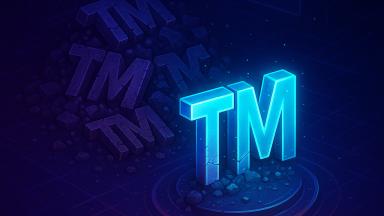From Idea to Ironclad: How AI Supercharges Trademark Protection

From Idea to Ironclad: How AI Supercharges Trademark Protection at Every Step
AI is quietly rewiring how fast-growing brands clear, file, and defend trademarks. The best part: you don’t need to be a lawyer—or buy enterprise software—to benefit. Public tools from the EUIPO and USPTO already use AI and modern search features to surface risks sooner and help you act faster. Below is a practical playbook you can use today, with pointers to official resources.
1) Why AI matters for trademark strategy now
Speed of brand growth means faster filing decisions. If you’re launching products, testing names, and entering new markets more often, waiting weeks for manual searches isn’t sustainable. WIPO reports that international trademark activity returned to growth in 2024—more applicants and more potential conflicts competing for distinct names. Faster insight is a competitive edge. WIPO press release (Mar 17, 2025).
Traditional reviews are slow, costly, and reactive. They often spot conflicts after filing, when you’re already invested in packaging, domains, and marketing.
AI enables real-time, scalable risk analysis. The EUIPO’s TMview uses AI-driven image search to find visually similar logos across the world’s largest free trade mark database—within seconds. EUIPO: AI image search in TMview.
2) Smarter pre-screenings and risk analyses
Scan millions of records instantly across jurisdictions. Start with official databases: EUIPO’s TMview/eSearch plus and the USPTO’s modern, cloud-based Trademark Search system. Both support deeper, faster screening than legacy tools. USPTO Trademark Search portal; system updates.
Detect confusing similarities—phonetic, visual, conceptual. The USPTO explains that likelihood of confusion can arise from similarity in sound, appearance, meaning, or overall commercial impression—so simple exact-match searches aren’t enough. USPTO: Likelihood of confusion.
Make your results actionable with risk scores. The EUIPO offers an automated “similarity report” and free tools for class selection (TMclass) and goods/services similarity benchmarking used by participating IP offices—handy for gauging how examiners compare goods and services. EUIPO search availability; TMclass FAQ; Similarity tool overview via BOIP.
Avoid costly rebrands and refusals. Early, AI-assisted clearance helps you adapt before filing—adjusting the mark or goods/services to sidestep conflicts that commonly trigger refusals. The USPTO stresses comprehensive pre-filing searches to reduce likelihood-of-confusion refusals. USPTO: Grounds for refusal.
3) AI-powered opposition management
Catch oppositions early with monitoring. In the EU, every EUTM is published and open to opposition for three months after publication; you can set alerts in your EUIPO User Area. In the U.S., marks publish in the weekly Trademark Official Gazette and are open to opposition for 30 days (with limited extensions). EUIPO: After applying (3‑month period); USPTO: Approval for publication (30‑day period); TTAB: Initiating an opposition.
Use AI to triage and predict. Historical data (outcomes by ground, mark similarity, channels of trade) can inform estimates on “likelihood of confusion” and procedural posture. While the agencies don’t provide outcome predictors, their guidance shows which factors matter; using them to build your internal scoring model helps prioritize disputes. USPTO likelihood-of-confusion factors.
Respond faster with data-backed arguments. The USPTO’s modern search and the EUIPO’s tools help you quickly assemble comparable marks, goods/services similarities, and proof-of-use demands where appropriate—accelerating draft oppositions or responses. USPTO search system updates; TMclass.
4) Cancellation proceedings and portfolio defense
Spot weak marks in competitor portfolios. In the EU, a registration can be revoked for non‑use after five consecutive years; in both EU and U.S. systems, marks that become generic or misleading can be attacked. Build AI dashboards to flag non‑use risk (no marketplace presence, no packaging hits, inactive websites). See EU law on revocation grounds. EUTMR Art. 58/59 (WIPO-Lex).
Find patterns of non‑use or genericity. Automate evidence gathering across markets: crawl public product listings, social posts, and press mentions to check genuine use and distinctiveness signals (then have humans verify). EU case law confirms the five-year “use” rule and its consequences in opposition and cancellation contexts. CJEU excerpts on genuine use.
Know the official filing routes. EUIPO provides online forms for revocation/invalidity; Trademark Trial and Appeal Board (TTAB) handles U.S. cancellations. Align your automation (dossier builders, exhibits, timelines) with these procedures. EUIPO online services (revocation/invalidity); USPTO TTAB overview.
5) Cease & desist letters with AI support
Tailor letters to the strength of your claim. Use AI to synthesize evidence (dates, channels, look/sound/meaning comparisons) and to insert relevant classification/similarity insights. Reference official likelihood-of-confusion factors so your message mirrors examiner and TTAB framing. USPTO: Likelihood of confusion.
Forecast settlement vs. escalation. Train a simple internal model on your past matters: recipient profile, market overlap, seniority, and strength of evidence. While most agencies don’t provide predictive tools, your own outcomes data can guide tone and demands.
Align tone with business goals. For marketplace takedowns or reseller issues, a collaborative tone may resolve faster; for counterfeiters, a firm deterrent stance may be warranted. Keep a “fast facts” annex auto-generated from your search snapshots and evidence log.
6) Why human expertise still matters
AI is a force multiplier, not a replacement. AI accelerates searches, surfaces look‑alikes, and drafts structured arguments—but strategy, judgment, and negotiation still come from experienced counsel.
Context decides close calls. “Similarity” is holistic: channels of trade, purchasers, and commercial impression matter. Officials highlight that similar marks aren’t automatically confusing without related goods/services. USPTO guidance.
The winning formula: AI + expert review = faster, stronger, cheaper protection. Use AI to cover more ground; use experts to call the plays when risk is gray.
7) Action plan for scaleups: Integrate AI into your trademark workflow
Step A — Modernize your search stack (today)
EU screening: Run TMview image searches and EUIPO similarity reports; use TMclass to tighten goods/services. AI image search (TMview); EUIPO search availability/similarity report; TMclass.
U.S. screening: Use the USPTO’s cloud-based Trademark Search with expert options and summary pages when logged in. USPTO: New search system; Updates and features.
Build a “confusion checklist.” Bake into your process: sound, look, meaning, commercial impression, and related goods/services. USPTO guidance.
Step B — Automate monitoring and alerts
EU: After filing, diarize the 3‑month opposition window and set alerts for similar later filings via your EUIPO User Area. EUIPO: After applying.
U.S.: Track the weekly Trademark Official Gazette and configure watch alerts; be ready to request an opposition extension within 30 days if needed. USPTO TMOG; ESTTA opposition/extension forms.
Step C — Standardize dispute playbooks
Oppositions (EU): Prepare cooling‑off negotiation templates; train your team to use goods/services similarity findings to narrow conflicts quickly. EUIPO search availability; Similarity tool overview via BOIP.
Oppositions (U.S.): Calendar the 30‑day opposition window from publication; TTAB allows limited extensions with rules-based criteria. TTAB: Initiating an opposition; ESTTA: Extensions.
Cancellation/Revocation: In the EU, automate five‑year non‑use watchlists for rivals and evidence logs for your own marks; file revocation/invalidity via EUIPO’s online services when warranted. EUTMR Art. 58/59; EUIPO online services.
Step D — Budget smarter with AI
Automate the heavy lift: searches, report generation, monitoring, and first‑draft letters. Reserve attorney time for strategy, negotiations, and final filings.
Prioritize by risk tier: use dashboards to decide: file, adapt, or rebrand in hours—not weeks—based on objective similarity and use evidence.
Key official sources you can rely on
EUIPO tools and procedures: Search availability, similarity report; TMclass; Opposition timing; Online forms (opposition/revocation/invalidity); TMview AI image search.
EU legal framework: EUTMR Articles 58–59 (revocation/invalidity).
USPTO search and examination: Trademark Search portal; Search system updates; Likelihood of confusion; Publication and 30‑day opposition window; TTAB oppositions; ESTTA forms; Trademark Official Gazette.
Global filing context: WIPO registries grew in 2024 (2025 release); WIPI 2024 highlights.
Bottom line
AI won’t replace expert judgment—but it makes trademark protection dramatically faster, more thorough, and more cost‑effective. Use the official EUIPO and USPTO tools as your baseline, layer in AI-driven monitoring and drafting, and escalate the high‑stakes calls to experienced counsel. That mix gives scaleups the speed they need with the accuracy their brands deserve.
Need help operationalizing this? Our team blends best-in-class AI workflows with seasoned trademark counsel. We can audit your current process, stand up monitoring and dispute playbooks, and handle complex filings and negotiations across the EU and U.S. Get in touch to start protecting more, faster—at a lower total cost.


